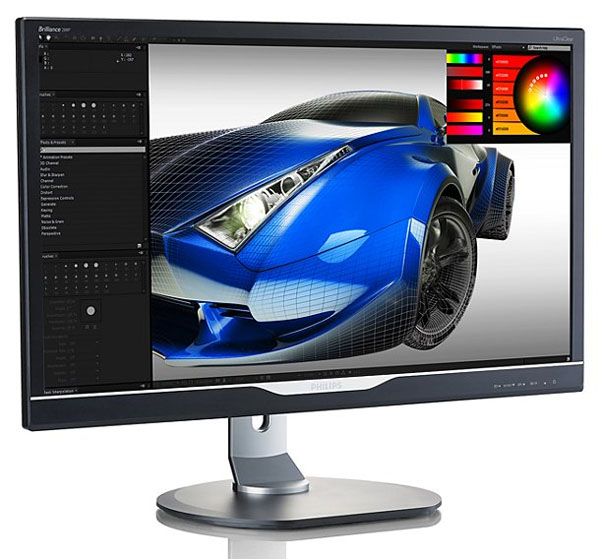Early Verdict
If the 288P6LJEB used the speedy control board found in Asus’ and Planar’s monitors, it would be a winner. If you aren’t looking for a gaming screen, it gets the job done based on perfectly acceptable color performance and excellent build quality.
Pros
- +
Decent color accuracy, excellent build quality, SmartControl software, easy 60Hz setup over DisplayPort 1.2, better-than-average speakers
Cons
- -
Middling contrast, higher-than-average input lag
Why you can trust Tom's Hardware
Philips 288P6LJEB 28-inch Ultra HD Monitor Review

Given high demand for inexpensive Ultra HD displays, it seems that 28-inch TN panels are appearing at an increasing rate. We’ve already reviewed new screens from Asus, Dell and Planar, finding them to be decent solutions for budget-conscious users looking for higher pixel density.
We covered the subject of pricing in Planar IX2850 28-Inch Ultra HD Monitor Review: Affordable 4K, but it bears repeating. If you want 4K today, you have three choices. At the high end are 32-inch IGZO panels from Dell, Asus and Sharp. They sell for between $2000 and $3000. The Dell UP3214Q offers a wide gamut option, while the other two are sRGB-only.
The next price point is between $1000 and $1500. That gets you a 24-inch AH-IPS panel from Dell or NEC, with an Adobe RGB option on both screens, along with superb color accuracy and decent contrast. We reviewed the UP2414Q and the EA244UHD and found them among the best displays we’d measured in all areas of performance.
For gamers, the best 4K products right now are the 28-inch TN panels. Viewing angles are not as good as IPS and you do give up a little contrast, but right now prices are stable at $600 and below. A couple of them add fast panel response and low input lag to the mix. We recorded excellent results from Asus's PB287Q and Planar's IX2850 that beat many QHD/IPS screens.
Today, we’re taking a look at our fourth example – Philips’ 288P6LJEB. Like the aforementioned group, it's attractively-priced. And according to our tests, it acquits itself as well in most areas of performance.
| Brand & Model | Philips 288P6LJEB |
|---|---|
| Panel Type & Backlight | TN / W-LED, edge array |
| Screen Size & Aspect Ratio | 28in / 16:9 |
| Max Resolution & Refresh Rate | 3840x2160 @ 60Hz |
| Native Color Depth & Gamut | 10-bit (8-bit w/FRC) / sRGB |
| Response Time (GTG) | 5ms |
| Brightness | 300cd/m2 |
| Speakers | 2 x 3W |
| Video Inputs | 1 x DisplayPort, 1 x HDMI/MHL,1 x DVI, 1 x VGA |
| Audio | 1 x 3.5mm / 1 x headphone |
| USB | v3.0 - 1 x up, 2 x downv2.0 - 2 x down |
| Panel DimensionsWxHxD w/base | 25.9 x 22.6 x 10.7in659 x 573 x 273mm |
| Panel Thickness | 2in / 50mm |
| Bezel Width | .7-1.3in / 18-33mm |
| Weight | 17.7lbs / 8kg |
| Warranty | Three years |
Innolux, formerly Chi Mei Optoelectronics, list only two versions of the same panel part in its catalog: a 28-inch TN screen with an 8-bit/FRC color depth for an effective 10-bit signal path (if you have the appropriate graphics hardware). The backlight is a white LED and its brightness is rated at 300cd/m2. The only difference between them is an apparent refresh for 2014.
To that component, Philips adds a full set of convenience features. You get plenty of inputs, including a legacy VGA port for analog signals. To operate the monitor at its native resolution, however, you need to use DisplayPort 1.2 for 60Hz or HDMI for 30Hz.
Unique to the 288P6LJEB is Philips’ SmartControl Premium software. It’s included on a CD in the box, or you can download it from the manufacturer’s website. It can help you with calibration by giving you desktop access to all image controls, along with test patterns. It doesn't work with any calibration instruments though. Adjustment with SmartControl is strictly by eye.
It also has a neat window management feature that automatically sizes and places applications in any on-screen configuration you desire, up to four quadrants. We’ve seen a similar tool bundled with AOC monitors.
Our initial impression of the first Philips monitor we've reviewed is that it has decent build quality, a useful set of extras and represents an inexpensive way to add 4K to your rig without breaking the bank. Let’s take a closer look.
Current page: Philips 288P6LJEB 28-inch Ultra HD Monitor Review
Next Page Packaging, Physical Layout And Accessories
Christian Eberle is a Contributing Editor for Tom's Hardware US. He's a veteran reviewer of A/V equipment, specializing in monitors. Christian began his obsession with tech when he built his first PC in 1991, a 286 running DOS 3.0 at a blazing 12MHz. In 2006, he undertook training from the Imaging Science Foundation in video calibration and testing and thus started a passion for precise imaging that persists to this day. He is also a professional musician with a degree from the New England Conservatory as a classical bassoonist which he used to good effect as a performer with the West Point Army Band from 1987 to 2013. He enjoys watching movies and listening to high-end audio in his custom-built home theater and can be seen riding trails near his home on a race-ready ICE VTX recumbent trike. Christian enjoys the endless summer in Florida where he lives with his wife and Chihuahua and plays with orchestras around the state.
-
envy14tpe It seems as though this is a 4k gaming monitor but I don't think that really lives up to the demand for fast fps gaming. 2160p sounds great but if its lag isn't that good it loses out to the 1440p 144Hz Asus PG278Q monitor. That seems more appropriate for gaming.Reply
I know this review is about 4k gaming but I'd like to see how the speed of a 1440p compares. There is a tradeoff when you take resolution over speed. -
ubercake Great review.Reply
If I'm looking in the $799 price range, I'm looking for higher-than-1080p resolutions and I'm either looking for the color accuracy of an IPS or PLS monitor for work purposes or I'm looking for TN gaming performance.
Since this is a TN monitor, we need to consider gaming performance. No G-sync at $799 retail? I can get the Acer 4K 60Hz with G-sync for this price or less. That's just too much for this Philips, but the Amazon price of around $580 seems closer to the target. Further, if a monitor is not using G-sync or a high refresh rate (120Hz+), I definitely wouldn't consider it for gaming. $580 might be worth simply upgrading to 4K though if you're on a 60Hz, but the contrast on this monitor kind of stinks.
Also, I'm not looking for color accuracy in a TN monitor. If I want color accuracy for matching print to screen colors, I'm looking at IPS or PLS options. On the other hand, when looking for a good TN monitor for gaming, you want good contrast for picking out bad guys in shadows and this monitor has not-so-good contrast.
I might consider this monitor for productivity, but nothing else. -
general lee "When viewed head-on, they are indistinguishable from an IPS monitor." Yeah, no. Put any solid Win 8 color to the desktop and see how the gamma shift makes upper and lower parts of the monitor look completely different, even when viewing head on. The new 4K TN panels might be color accurate to a calibrator, but it doesn't take into account the viewing angle, which is only 90 degrees in dead center of the monitor when viewed head on. These are simply not good for color accurate work, period. The same goes for VA's due to its gamma shift viewing cone. That said, these are better than the cheaper TN panels you find in budget models and 144 Hz monitors, and are good enough for non-color critical work. I'd still go for IPS for color work, and VA for media consumption due to it's superior contrast. TN is only good for fast-paced CS:GO type gaming where motion performance and visibility trumps any picture quality concerns.Reply -
ahnilated Why would you buy a monitor that is not true 4K resolution? 4096 X 2160 is true 4K resolution and not down sampled or just cut off.Reply -
Eggz Accuracy check on the following paragraph, concerning color reproduction of 4K displays:Reply
Tom's Hardware said:We covered the subject of pricing in Planar IX2850 28-Inch Ultra HD Monitor Review: Affordable 4K, but it bears repeating. If you want 4K today, you have three choices. At the high end are 32-inch IGZO panels from Dell, Asus and Sharp. They sell for between $2000 and $3000. The Dell UP3214Q offers a wide gamut option, while the other two are sRGB-only.
Is that correct about the Sharp display? It boasts a "1.07 Billion Color Palette." That's a 10-bit panel, I believe, unless there is some sort of trickery I'm not seeing. The touch version of the Sharp also has the same panel, boasting "1.07 billion colours." -
Eggz Accuracy check on the following paragraph, concerning color reproduction of 4K displays:Reply
Tom's Hardware said:We covered the subject of pricing in Planar IX2850 28-Inch Ultra HD Monitor Review: Affordable 4K, but it bears repeating. If you want 4K today, you have three choices. At the high end are 32-inch IGZO panels from Dell, Asus and Sharp. They sell for between $2000 and $3000. The Dell UP3214Q offers a wide gamut option, while the other two are sRGB-only.
Is that correct about the Sharp display? It boasts a "1.07 Billion Color Palette." That's a 10-bit panel, I believe, unless there is some sort of trickery I'm not seeing. The touch version of the Sharp also has the same panel, boasting "1.07 billion colours." -
Bondfc11 4K and gaming just don't mix right now. I am not a 120 or 144 hz snob by any means, but I just cannot go back to lower FPS and slightly increased lag. It is noticeable once you have been in a higher bracket for a period of time.Reply
I played a few games on a 28" ASUS and returned it - just couldn't take the pixel density (size issue on the desktop - I know scale scale scale, but I didn't like it), I didn't like the higher lag, lower FPS, and hated to have to drop the native resolution for some tasks.
Personally, I will not buy 4K until these issues are no longer issues. I find it funny when people say "well just scale up or change the native res to 1440/1080". Ok fine, but why buy 4K if you have to do those things? 4K and me are just not ready for prime time. -
wiyosaya Reply14714619 said:Oh, how I miss Sony and its Trinitron!
Agreed! Sony tossed innovation out the door when they hired its first western CEO. They have not quite yet figured out that innovation was what made Sony legendary even though they got rid of the western wonk.